Miele G 7857 Operating instructions

Operating instructions
Thermal Disinfector
G 7857
To avoid the risk of accidents or damage to the machine it is
essential to read these operating instructions before it is installed, commissioned and used for the first time.
G i
M.-Nr. 05 439 471

Contents
Description of the machine . . . . . . . . . . . . . . . . . . . . . . . . . . . . . . . . . . . . . . . . . . 3
Guide to the machine. . . . . . . . . . . . . . . . . . . . . . . . . . . . . . . . . . . . . . . . . . . . . . . 4
Warning and Safety instructions . . . . . . . . . . . . . . . . . . . . . . . . . . . . . . . . . . . . . 6
Caring for the environment . . . . . . . . . . . . . . . . . . . . . . . . . . . . . . . . . . . . . . . . . 10
Before using for the first time . . . . . . . . . . . . . . . . . . . . . . . . . . . . . . . . . . . . . . . 11
Opening and closing the door . . . . . . . . . . . . . . . . . . . . . . . . . . . . . . . . . . . . . . 12
Water softener . . . . . . . . . . . . . . . . . . . . . . . . . . . . . . . . . . . . . . . . . . . . . . . . . . . 14 Setting the water softener . . . . . . . . . . . . . . . . . . . . . . . . . . . . . . . . . . . . . . . . . . . 16 Filling the salt reservoir . . . . . . . . . . . . . . . . . . . . . . . . . . . . . . . . . . . . . . . . . . . . . 17 Salt indicator . . . . . . . . . . . . . . . . . . . . . . . . . . . . . . . . . . . . . . . . . . . . . . . . . . . . . 18
Loading the machine . . . . . . . . . . . . . . . . . . . . . . . . . . . . . . . . . . . . . . . . . . . . . . 19 Loading the machine . . . . . . . . . . . . . . . . . . . . . . . . . . . . . . . . . . . . . . . . . . . . . . . 19 Adjusting the top basket . . . . . . . . . . . . . . . . . . . . . . . . . . . . . . . . . . . . . . . . . . . . 22 Items not suitable for dishwashers . . . . . . . . . . . . . . . . . . . . . . . . . . . . . . . . . . . . 22
Adding rinsing agent or neutralising agent. . . . . . . . . . . . . . . . . . . . . . . . . . . . 23 Setting the dosage. . . . . . . . . . . . . . . . . . . . . . . . . . . . . . . . . . . . . . . . . . . . . . . . . 25
Adding cleaning agent. . . . . . . . . . . . . . . . . . . . . . . . . . . . . . . . . . . . . . . . . . . . . 26
Selecting a programme . . . . . . . . . . . . . . . . . . . . . . . . . . . . . . . . . . . . . . . . . . . . 29
Programme chart . . . . . . . . . . . . . . . . . . . . . . . . . . . . . . . . . . . . . . . . . . . . . . . . . 30
Operation . . . . . . . . . . . . . . . . . . . . . . . . . . . . . . . . . . . . . . . . . . . . . . . . . . . . . . . 34 Switching on . . . . . . . . . . . . . . . . . . . . . . . . . . . . . . . . . . . . . . . . . . . . . . . . . . . . . 34 Starting a programme. . . . . . . . . . . . . . . . . . . . . . . . . . . . . . . . . . . . . . . . . . . . 34 Changing a programme . . . . . . . . . . . . . . . . . . . . . . . . . . . . . . . . . . . . . . . . . . 35 Selecting an additional function . . . . . . . . . . . . . . . . . . . . . . . . . . . . . . . . . . . . 35 Programme sequence indicators . . . . . . . . . . . . . . . . . . . . . . . . . . . . . . . . . . . 35 Switching off. . . . . . . . . . . . . . . . . . . . . . . . . . . . . . . . . . . . . . . . . . . . . . . . . . . . . . 35 To cancel a programme . . . . . . . . . . . . . . . . . . . . . . . . . . . . . . . . . . . . . . . . . . . . . 36
Programming special functions . . . . . . . . . . . . . . . . . . . . . . . . . . . . . . . . . . . . . 37
Cleaning and care . . . . . . . . . . . . . . . . . . . . . . . . . . . . . . . . . . . . . . . . . . . . . . . . 45
Correcting minor faults . . . . . . . . . . . . . . . . . . . . . . . . . . . . . . . . . . . . . . . . . . . . 49 Customer service. . . . . . . . . . . . . . . . . . . . . . . . . . . . . . . . . . . . . . . . . . . . . . . . . . 50
Installation . . . . . . . . . . . . . . . . . . . . . . . . . . . . . . . . . . . . . . . . . . . . . . . . . . . . . . 51
Electrical connection . . . . . . . . . . . . . . . . . . . . . . . . . . . . . . . . . . . . . . . . . . . . . 53
Plumbing. . . . . . . . . . . . . . . . . . . . . . . . . . . . . . . . . . . . . . . . . . . . . . . . . . . . . . . . 54
Technical data . . . . . . . . . . . . . . . . . . . . . . . . . . . . . . . . . . . . . . . . . . . . . . . . . . . 57
2

Description of the machine
The G 7857 TD is a special freshwater machine, suitable for use in isolation ward kitchens, old people’s homes, care centres, convalescence homes etc.
A thermal disinfection process is available for treating potentially infectious crockery in ward kitchens. The DESIN Vario TD programme offers thermal disinfection in accordance with general hygiene standards, and the DESIN 93°C/10’ programme meets the requirements of IfSG on containing the spread of epidemics.
In Germany, the parameters for disinfection of a temperature of 93 °C with a holding time of 10 minutes, corresponding to effective areas A and B have been adopted into the official list for disinfection of instruments in disinfectors and decontamination units, according to section 3.2.4. § 18 IfSG by the Robert Koch Institute (RKI) in Berlin (German Institute for Infectious Diseases and Non-communicable Illnesses).
The degree of efficiency is defined as follows:
A = Suitable for the destruction of vegetative bacteria, including myco-bacteria, fungi and fungal spores.
B = Suitable for inactivating viruses (including HBV and HIV).
This machine must not be used for cleaning or disinfecting products classed as medical products according to the MDD directive 93/42/EWG, Class IIa.
This thermal disinfector is equipped as standard with a steam condenser (DK) and water softener.
3
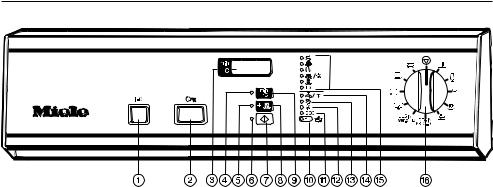
Guide to the machine
a On/Off button (I-0)
b Door release button
c Display
dDelay start indicator light (see Programming special functions)
e Drying indicator light
f Programme start indicator light
g Start button
h Drying button
iButton to change between the current temperature and elapsed time in the display
j Add neutralising agent indicator light
It is also used as the optical interface for service technicians
kAdd liquid cleaning agent indicator light (only applies to machine fitted with an optional external DOS module)
l Add rinsing agent indicator light
m Add salt indicator light
nCheck water inlet/outlet indicator light
oProgramme sequence indicator lights
p Programme selector
4
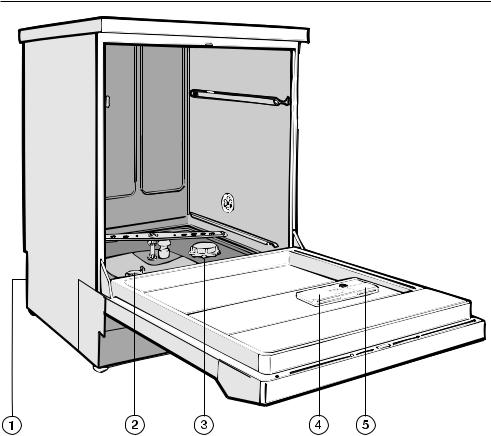
Guide to the machine
aConnection for DOS module (optional dispenser pump for liquid cleaning agent) at the rear of the machine
b Filter combination
cSalt reservoir
(for the water softener)
d Dispenser for powder cleaning agent
eDispenser for rinsing agent or neutralising agent (with dosage selector)
5
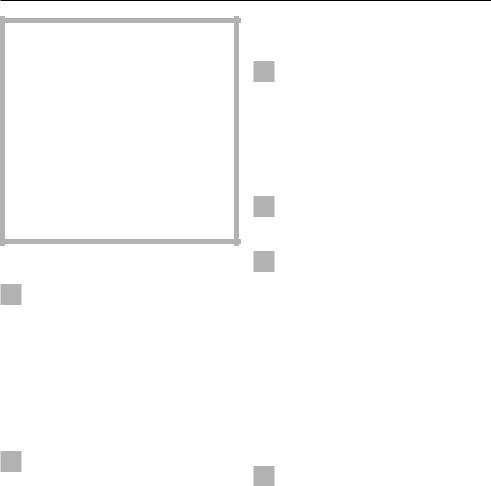
Warning and Safety instructions
This machine complies with all relevant local and national safety requirements. Incorrect use can, however, lead to personal injury and damage to property.
Read the operating instructions carefully before starting to use this machine. This way you will avoid the risk of accidents and damage to the machine.
Keep these instructions in a safe place for reference, and pass them on to any future user.
Correct use
This machine is designed for commercial use and for specialised
applications only, as described in these Operating Instructions. Alterations to the machine, or using it for purposes other than those for which it was designed, are unauthorised and could cause harm. The manufacturer cannot be held liable for damage caused by improper or incorrect use of the machine.
This equipment is not designed for maritime use or for use in mobile
installations such as caravans, aircraft etc. However it may be suitable for such usage subject to a risk assessment of the installation being carried out by a suitably qualified engineer.
Please pay attention to the following notes to avoid injury and damage.
This machine should be commissioned and then
maintained by a Miele authorised and trained service technician or other suitably qualified and competent approved person. Repairs and other work by unqualified persons could be dangerous.
Do not install the machine in an area where there is any danger of
explosion or of freezing conditions.
The electrical safety of this machine can only be guaranteed if
connected to a correctly installed earthing system on site. It is imperative that this basic safety requirement is tested regularly and, where there is any doubt, the electrical wiring system on site should be inspected by a qualified electrician.
The manufacturer cannot be held liable for damage or injury caused by the lack of or inadequacy of an effective earthing system (e.g. electric shock).
A damaged machine is dangerous. Switch off at the mains immediately
and call the Miele Service Department or an authorised and trained Miele Service Dealer or other suitably qualified and competent approved person.
6

Warning and Safety instructions
Personnel operating the machine should be trained regularly.
Untrained personnel must not be allowed access to the machine or its controls.
This machine is not a toy! Do not allow children to play in or around it, or to operate it. There is a danger they could injure themselves, or get into the machine and lock themselves in.
Take great care when handling liquid agents and additives. These
may contain irritant or corrosive ingredients. Do not use organic solvents as these could cause an explosion.
Follow all relevant safety procedures carefully. Wear protective gloves and goggles. With all chemical agents, the manufacturer’s safety conditions must be observed.
Avoid inhalation of powder cleaners. They can cause burning
in the mouth and throat if swallowed, and can inhibit breathing.
The water in the machine must not be used as drinking water.
Do not sit or lean on an open door. The machine could tip up and be
damaged or cause an injury.
Be careful when sorting items with sharp pointed ends and
positioning them in the machine that you do not hurt yourself or create a danger for others. Sharp knives etc. should be placed in baskets with the pointed end facing downwards.
When using this machine in the higher temperature ranges, be
especially careful not to scald or burn yourself when opening the door. Baskets and inserts must be allowed to cool down before they are unloaded. Any water remaining in containers could still be very hot. Empty them into the wash cabinet before taking them out.
Do not touch the heating elements if you open the door during or directly after the end of a programme: you could burn yourself. They remain hot for some
time after the end of the programme.
Never clean the machine or near vicinity with a water hose or a high
pressure hose.
Before any maintenance or repair work is carried out, the machine
must be disconnected from the mains supply by switching off at the mains isolator or withdrawing the mains fuse.
The following points should be observed to assist in maintaining quality standards, to protect users, and to avoid damage to the machine and items being cleaned.
If the machine is being used for disinfection in accordance with
official regualtions on the control of epidemics, the steam condenser and its connections to and from the wash cabinet must be cleaned and disinfected whenever any repairs are carried out or parts replaced.
7

Warning and Safety instructions
When running a disinfecting programme in accordance with
official regulations on the control of epidemics, the programme must not be interrupted once it has been started (see Cancelling a programme in an emergency).
The standard of disinfection in the disinfection programmes must be
routinely confirmed by the user. The process should be regularly monitored using thermo-electrical, chemical or bio-indicators, and this should be fully documented.
Disinfection programmes must not be interrupted as this can have a
limiting effect on the disinfection result. If interruption is unavoidable, however, the complete programme must be repeated.
For thermal disinfection, use temperatures and temperature
holding times to achieve the required infection prophylaxis in accordance with current health and safety regulations.
Only use Miele approved cleaning agents in this machine. Using
unsuitable cleaning agents could adversely affect the components of the machine, as well as items being cleaned.
For pre-treatment and/or cleaning, only use low-foaming cleaning and
disinfecting agents which have been approved by Miele. Foam can have an adverse effect on the disinfection and cleaning process.
Where a chemical additive is recommended on technical application grounds (e.g. a cleaning agent), this does not imply that the manufacturer of the machine accepts liability for the effect of the chemical on
the items being cleaned.
Please be aware that changes in formulation, storage conditions etc. which may not be publicised by the chemical manufacturer, can have a negative effect on the cleaning result.
When using cleaning agents and special application chemicals, it is
essential that the manufacturer’s instructions are followed. Only use such chemicals for the purpose and in the situation specified, to the exclusion of other chemicals, to avoid such dangers as chemical reactions and material damage.
The machine is designed for operation with water and additive
cleaning agents only. Organic solvents must not be used in this machine, as there is the danger under certain circumstances of fire or explosion. (Although this is not the case with all organic solvents, other problems could arise with their use, for example damage to rubber and synthetic materials).
In critical applications where very stringent requirements have to be
met, it is strongly recommended that all the relevant factors for the process, such as cleaning agent, water quality etc. are discussed with the Miele Application Technology specialists.
8

Warning and Safety instructions
If cleaning and rinsing results are subject to particularly stringent
requirements (e.g. chemical analysis, specialised industrial processes etc.), a regular quality control test must be carried out by the user to ensure that required standards of cleanliness are being achieved.
The special inserts should only be used for their specific application.
Hollow instruments must be thoroughly cleaned, internally and externally.
Empty any containers or utensils before arranging them in the
machine.
Do not allow any remains of acids or solvents, and in particular
hydrochloric acid or chloride solutions, to get into the wash cabinet. Similarly avoid any materials with a corrosive effect.
The presence in compounds of any solvents should be minimal (especially those in hazard class A1).
To avoid any corrosion damage, ensure that solutions or steam
containing hydrochloric acid do not come into contact with the steel outer casing of the machine.
Please follow the advice on installation in these instructions
and the separate Installation Instructions.
Using accessories
Only use genuine Miele accessories with this machine.
Consult Miele on the type and application of such equipment.
Disposal of your old machine
Before disposing of your old machine first make it unusable.
Disconnect from the mains, cut off the cable near the machine and any plug from the cable.
For environmental and safety reasons ensure the machine is completely drained of any residual water and cleaning agent. (Observe safety regulations and wear safety goggles and gloves).
Make the door lock inoperative, so that children cannot accidentally shut themselves in. Then make appropriate arrangements for the safe disposal of the machine.
The manufacturer cannot be held liable for damage caused by non-compliance with these Warning and Safety instructions.
9

Caring for the environment
Disposal of the packing material
The transport and protective packing has been selected from materials which are environmentally friendly for disposal and can normally be recycled.
Ensure that any plastic wrappings, bags etc. are disposed of safely and kept out of the reach of babies and young children. Danger of suffocation.
Rather than just throwing these materials away, please ensure that they are recycled.
Disposal of your old appliance or machine
Electrical and electronic appliances / machines often contain materials which, if handled or disposed of incorrectly, could be potentially hazardous to human health and to the environment. They are, however, essential for the correct functioning of your appliance or machine. Please do not therefore dispose of your old machine or appliance with your household waste.
Please dispose of it at your local community waste collection / recycling centre and ensure that it presents no danger to children while being stored for disposal.
It should be unplugged or disconnected from the mains electricity supply by a competent person. The plug must be rendered useless and the cable cut off directly behind it to prevent misuse. See the "Warning and Safety" section of this booklet for further details.
10

Before using for the first time
Before using for the first time please pay special attention to the following points.
Detailed information on these points can be found in the relevant sections of these Operating Instructions.
Set the water softener unit
The water softener unit must be set for the water hardness level in your area.
The salt reservoir also has to be filled, first with water and then with reactivation salt.
,Filling the salt reservoir with cleaning agent by mistake will cause serious damage to the water softener. Please check every time before refilling that the package contains reactivation salt.
Add rinsing agent
,Inadvertently filling the reservoir for rinsing agent with cleaning agent (including liquid cleaning agents and washing up liquid) will cause serious damage to the reservoir.
Only use designated cleaning agents for special applications.
Do not use cleaning agents formulated for use in domestic dishwashers.
Load the machine carefully
Arrange the load so that water will come into contact with all surfaces. Concealed surfaces will not be cleaned.
The spray arms must not be blocked by any items.
Add cleaning agent
Follow the cleaning agent manufacturer’s recommendations on dosage.
The amount required will depend on the type of cleaning agent and the programme chosen.
Make sure you read the notes on dosing given in the programme chart.
Cleaning results may vary from brand to brand. If you are not satisfied with the results from one brand, try another quality brand before contacting Miele for advice.
The filter combination at the base of the wash cabinet and the spray arms must be kept clean.
Regular checking and cleaning is essential.
11

Opening and closing the door
Electro-thermal door lock
The machine is equipped with an electro-thermal door lock.
The door can only be opened when:
^the electricity supply to the machine is switched on, and
^the main switch I-0 is pressed in.
The door locks approx. 1 1/2 mins. after the programme has started, except in the D PRE-RINSE and 6 DRAIN programmes and during the drying phase (additional programme).
The door remains locked until the end of the programme, when it can be opened again.
To open the door a
^Press the door button in as far as it will go, and at the same time, grip the handle and open the door.
,Do not touch the heating elements if you open the door during or directly after the end of a programme: you could burn yourself. The elements remain hot for some time after the end of the programme.
With the J (SUPER SHORT) programme the door must be kept closed between batches because of the build-up in the machine of condensed water (it could otherwise cause corrosion or damage to surrounding furniture. See advice in the Installation section).
To close the door
^Lift the door upwards and push until it clicks shut. Do not press the door release button whilst shutting the door.
To cancel a programme
If a programme has to be cancelled in extreme cases, e.g. when articles in the machine jostle against each other or the programme is interrupted with a fault indication, the door must be opened (deliberate intervention):
^Turn the programme selector to the f position (the programme is cancelled after approx. 2 secs.).
Important
It is essential to follow procedures, particularly with regard to regulations on preventing the spread of epidemics, as described in Operation - cancelling a programme.
12
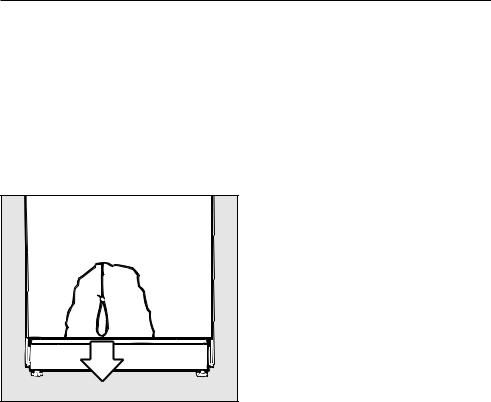
Opening and closing the door
To open the door with the emergency release
The emergency release should only be used when the door cannot be opened normally, e.g. in the event of a power failure. Important note for DESIN programmes
^ Turn the programme selector to f.
^ Press I-0 to switch the machine off. |
^Pull down the emergency release cord behind the door outer panel.
13

Water softener
The water needs to be softened to avoid calcium deposits building up on utensils and in the machine itself.
To ensure a steady supply of soft water, the water softener unit must always be:
1.correctly programmed and
2.the salt reservoir must be filled.
If the water hardness level is below 4 °d - German scale (0.7 mmol/l), the reservoir does not need to be filled with reactivation salt.
The machine is set at the factory for a water hardness level of 19 °d (3.4 mmol/l).
If the water supply is harder or softer than this (including below 4 °d or 0.7 mmol/l), the factory setting will need to be changed following the instructions in Setting the water softener. See chart on the next page for settings.
Your local water authority will advise you on the water hardness in your area.
For fluctuating levels e.g. 8 - 17 °d (1.4 - 3.1 mmol/l) set the water softener to the highest setting. In this example to 17 °d (3.1 mmol/l).
Important
The built-in water softener has settings from 1 °d - 60 °d (0.2 - 10.8 mmol/l).
For future servicing it is useful to make a note of your water hardness level.
^ Enter your water hardness level here: °d / mmol/l
14

Water softener
Table of settings
|
|
|
|
°d |
mmol/l |
°f |
Setting |
(German |
|
|
|
scale) |
|
|
|
|
|
|
|
1 |
0.2 |
2 |
1 |
2 |
0.4 |
4 |
2 |
3 |
0.5 |
5 |
3 |
4 |
0.7 |
7 |
4 |
5 |
0.9 |
9 |
5 |
6 |
1.1 |
11 |
6 |
7 |
1.3 |
13 |
7 |
8 |
1.4 |
14 |
8 |
9 |
1.6 |
16 |
9 |
10 |
1.8 |
18 |
10 |
11 |
2.0 |
20 |
11 |
12 |
2.2 |
22 |
12 |
13 |
2.3 |
23 |
13 |
14 |
2.5 |
25 |
14 |
15 |
2.7 |
27 |
15 |
16 |
2.9 |
29 |
16 |
17 |
3.1 |
31 |
17 |
18 |
3.2 |
32 |
18 |
19 |
3.4 |
34 |
19 *) |
20 |
3.6 |
36 |
20 |
21 |
3.8 |
38 |
21 |
22 |
4.0 |
40 |
22 |
23 |
4.1 |
41 |
23 |
24 |
4.3 |
43 |
24 |
25 |
4.5 |
45 |
25 |
26 |
4.7 |
47 |
26 |
27 |
4.9 |
49 |
27 |
28 |
5.0 |
50 |
28 |
29 |
5.2 |
52 |
29 |
30 |
5.4 |
54 |
30 |
31 |
5.6 |
56 |
31 |
32 |
5.8 |
58 |
32 |
33 |
5.9 |
59 |
33 |
34 |
6.1 |
61 |
34 |
35 |
6.3 |
63 |
35 |
36 |
6.5 |
65 |
36 **) |
37 |
6.7 |
67 |
37 |
38 |
6.8 |
68 |
38 |
39 |
7.0 |
70 |
39 |
40 |
7.2 |
72 |
40 |
41 |
7.4 |
74 |
41 |
42 |
7.6 |
76 |
42 |
43 |
7.7 |
77 |
43 |
44 |
7.9 |
79 |
44 |
45 |
8.1 |
81 |
45 |
|
|
|
|
|
|
|
|
|
|
|
|
°d / |
mmol/l |
°f |
Setting |
mmol/l |
|
|
|
|
|
|
|
46 |
8.3 |
83 |
46 |
47 |
8.5 |
85 |
47 |
48 |
8.6 |
86 |
48 |
49 |
8.8 |
88 |
49 |
50 |
9.0 |
90 |
50 |
51 |
9.2 |
92 |
51 |
52 |
9.4 |
94 |
52 |
53 |
9.5 |
95 |
53 |
54 |
9.7 |
97 |
54 |
55 |
9.9 |
99 |
55 |
56 |
10.1 |
101 |
56 |
57 |
10.3 |
103 |
57 |
58 |
10.4 |
104 |
58 |
59 |
10.6 |
106 |
59 |
60 |
10.8 |
108 |
60 |
|
|
|
|
|
|
|
|
*) factory setting **) 1-36 only for U.K.
Machines without a water softener are set to 0 at the factory. This setting of 0 must not be changed on these machines.
15

Water softener
Setting the water softener
^Switch the machine off.
^Turn the programme selector to the STOP position f.
^Press 4 and 6 at the same time, hold them in and, whilst doing so, switch the machine on with the I-0 button.
The current programme status "P..." will show in the display.
The indicator light p / 6 will come on.
^Press 3 once. E01 for programming level 1 will appear in the display.
^Turn the programme selector six switch positions clockwise (6 o’clock position).
The number 19 will appear in the display (the factory water hardness setting in °d, equivalent to 3.4 mmol/l).
^Press 4 as many times as is necessary, or hold it in until the required value (hardness level in °d) appears in the display.
Once the number 60 (36 only for U.K.) has been reached, the counter will begin again at 0.
^Press the 6 button. SP appears.
^Press 6 again. The setting will now be stored in the memory. The display clears.
^The machine is now ready for operation.
16
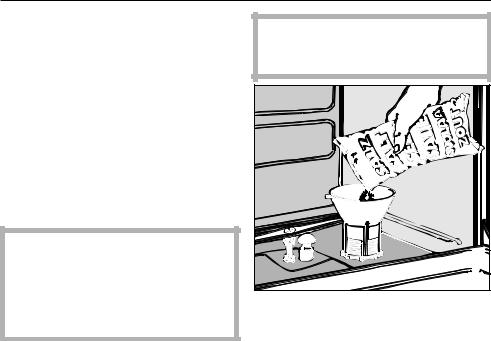
Water softener
Filling the salt reservoir
Please only use special coarse grained reactivation salt with granules of approx. 1-4 mm. Do not use other types of salt, e.g. table salt, agricultural or gritting salt. These could contain components which are insoluble in water which could result in damage to the water softener. If in doubt consult your Miele Professional Department.
The salt reservoir holds approx. 2.5 kg of salt.
,Inadvertently filling the salt reservoir with cleaning agent will damage the water softener.
Before filling the salt reservoir make sure that you have picked up the right packet of reactivation salt.
^Remove the bottom basket from the machine.
^Unscrew the salt reservoir cap.
Before filling the salt reservoir with reactivation salt for the first time, fill it with approx. 2.5 litres of water.
^Place the funnel provided in place.
^Fill carefully with salt. As it is filled, displaced water will run out).
^Wipe any residual salt off the screw threads on the socket.
^Screw the cap on firmly.
^Immediately after this: Run the PRE-RINSE programme D to remove any traces of salt from the cabinet.
Important: If after starting the PRE-RINSE programme D the machine does not start for a few minutes this is not a fault. The water softener is being reactivated.
17
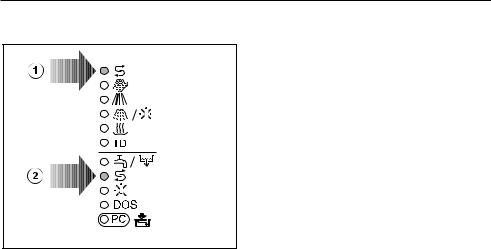
Water softener
Salt indicator
When the salt reservoir is empty the k indicator light b comes on to remind you to fill the reservoir.
Reactivation takes place automatically during a programme.
The programme sequence indicator light k a lights up whilst this is happening.
18
